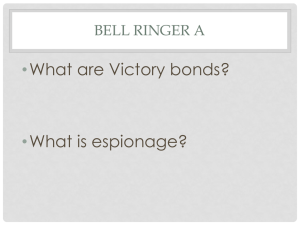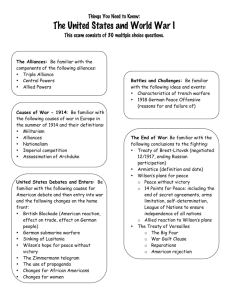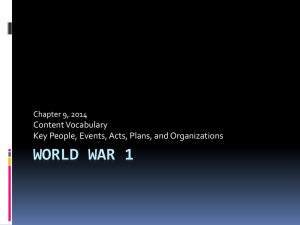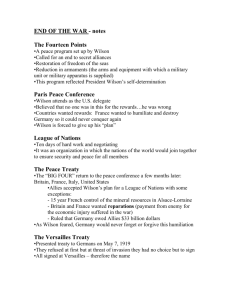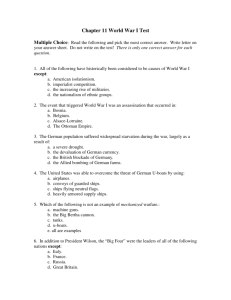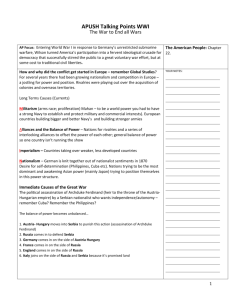American History Chapter 9 On-Line Study Guide
advertisement
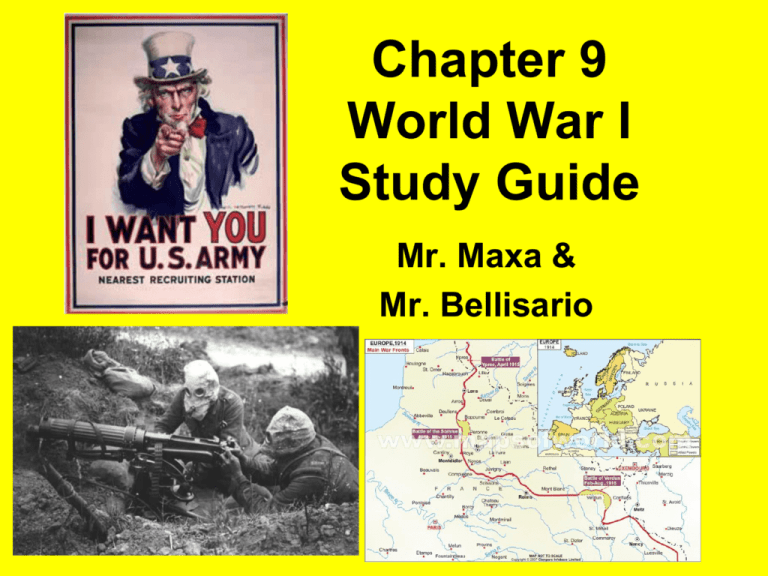
Chapter 9 World War I Study Guide Mr. Maxa & Mr. Bellisario Table of Contents • • • • Go to the start of Section 1 Go to the start of Section 2 Go to the start of Section 3 Go to the start of Section 4 Section 1 Triple Alliance • Germany joined Italy and Austria-Hungary to form the Triple Alliance. Militarism • • In the late 1800s, Germany and France were enemies. The system of alliances encouraged militarism – the buildup of armed forces. Nationalism • Nationalism is intense pride in one’s homeland. National self-determination in the Balkans • Countries in the Balkan Peninsula wanted boarders of a country based on ethnicity. Serbia – 1st to get Independence • Serbia gained their independence from the Ottoman Empire in 1815. • Before World War I, their biggest fear was annexation by Austrian-Hungarian Empire. Archduke Franz Ferdinand • • • In the city of Sarajevo, capital of Bosnia, the heir to the AustroHungary throne (i.e., Franz Ferdinard) planned to visit. On June 28, 1914, a Bosnian member of a Serbian nationalist group killed the heir. Austria-Hungary issues an ultimatum to Serbia but Serbia turns to Russia and France for help. War Erupts • On July 28, 1914 Austria-Hungary declared war on Serbia. • Russia immediately mobilized their army along the German boarder. • On August 1, 1914, Germany declared war on Russia and two days later, declared war on France. Allied Powers • Great Britain, France, and Russia joined together to form the Allied Powers. Central Powers • Germany & AustriaHungary Germany fights a two sided war • Germany had to fight British and French troops on the Western Front while fighting the Russians on the Eastern Front. America at the start of the war • As World War I began, President Wilson declared that United Sates was neutral. • However, Americans did take sides – Most Americans favored the Allies and so did president Wilson’s cabinet. – The British also worked to win U.S. support. German U-Boat Controls the Seas • German u-boats controlled the seas around the coasts of Britain and France. • Sank many ships. Sinking of the Lusitania • In May 1915, the British passenger ship, Lusitania entered the war zone. • A German U-boat or submarine, sank the ship killing nearly 1,200 people including 128 Americans. German promises no more unrestricted submarine warfare • After a U-boat shot at the French passenger ship Sussex, Wilson warned Germany to stop its submarine warfare or risk war with the United States. • Germany did not want the United States to join the Allies. • In the Sussex Pledge, Germany promised not to sink any merchant ships without warning. Zimmerman Pledge • In January 1917, a German official named Arthur Zimmermann told the German ambassador to Mexico to ask Mexico to ally itself with Germany in case of war between Germany and the United States. – In return, Mexico would get back territory it lost during the Mexican War. • The British intercepted the Zimmermann telegram. – It was leaked to American newspapers. • Many Americans now believed that war with Germany was necessary. Wilson’s promises to “keep the world safe for democracy” • In February 1917, Germany again began unrestricted submarine warfare. • Finally, after Germany sank six American merchant ships, Wilson asked Congress to declare war on Germany. • Declaration of war was officially declared on April 6th ,1917. Section 2 War Industries Board (WIB) • This board helped coordinate the production of war materials. Food Administration – Herbert Hoover • Most successful government agency during the war. • This agency encouraged Americans to observe “Wheatless Mondays”. Victory Gardens • Home gardens called, “Victory gardens” were promoted so that less people would buy food and more food could be shipped overseas. Fuel Administration • The Fuel Administration introduced daylight saving time and shortened workweeks to conserve energy. • This agency encouraged Americans to observe “Heatless Tuesdays”. Paying for the World War I • To help fund the war effort, congress raised income tax rates. • The government also raise money to fight the war by selling war and liberty bonds. National War Labor Board • The goal of The National War Labor Board (NWLB) tried to avoid labor strikes. Great Migration • In the “Great Migration”, many African Americans left the South to take jobs in the northern factories. Committee on Public Information • The Committee on Public Information (CPI) was led by George Creel. • The CPI’s primary job was to sell the war to the American people. • The CPI hired advertises to creating posters promoting the draft, artists developing songs and poems supporting the war, and having people give “Four Minute Speeches”. Espionage & Sedition Act • To limit criticism of the war, congress passed the Espionage & Sedition Acts. • The goal of the Espionage Act was to fight potential spying. • The Sedition Act made illegal to speak out against the war publicly. Schenck v. United States • Case made it to the U.S. Supreme Court. • The court’s majority opinion ruled that freedom of speech could be curbed in wartime if it presents a, “clear and present danger”. Selective Service – The Draft • More soldiers were needed to fight the war. • Congress believed conscription (draft) was necessary. – It set up a new system of conscription called selective service. • It required all men between 21 and 30 to register for the draft. African Americans in the Army • African American soldiers in World War I served separately from white male soldiers. Women in the Army • During World War I, women in the armed services performed nursing and clerical duties. Section 3 The Western Front • The area between the opposing trenches was called “No Man’s Land” because nothing existed in that space. New Technology • One of the new technologies of modern warfare was the machine gun. • To avoid being shot by the machine gun, armies built trenches. Airplanes and Zeppelins • • Airplanes were first used in World War I, to observe enemy activities. As the war progressed, airplanes would engage in dogfights with machine guns attached to the aircraft. Convoy System • To minimize damage by German uboats, American transports used the convoy system to cross the Atlantic Ocean. Russia pulls out of war • In March 1917, riots broke out in Russia and its leader stepped down. • A temporary government was unable to deal with the country’s major problems. • The Bolshevik Party led by V.I. Lenin overthrew the Russian government. • Lenin immediately pulled Russia out of the war, allowing Germany to concentrate its troops on the Western Front. American fight separate in Europe • General Pershing insisted that American soldiers fight under American commanders. Armistice Declared • On November 11, 1918, an armistice was declared by Germany and thus fighting stopped on the Western Front. Treaty of Versailles (Big 4) • The Big Four representing the Allied Powers included leaders from France, U.S., Italy, and France. Wilson’s 14 Points • President Wilson’s plan for peace that he took with him to Paris. League of Nations • The League of Nations was the idea of President Wilson. • He wanted the League of Nations to be a global alliance to stop aggression and promote peace. European Allies seek revenge from WWI • Britain and France wanted to punish Germany. • In the Treaty of Versailles, they made Germany admit their guilt in causing World War I, taking blame for all the damages. • Germans were also required to pay reparations. U.S. Senate rejects Treaty of Versailles – Why? • U.S. Senate rejected the Treaty because President Wilson refused to take any Republican leaders with him to the peace conference. • Also, the treaty would take away their war powers (to declare war). Wilson’s speaking tour & collapse • President Wilson wanted to take his message directly the American people and try to win support for the treaty. • With the stroke disables the president, the U.S. never joins the League of Nations. Section 4 Soldiers Returning • When the soldiers returned home from the war, they found: – No jobs – Thousands of union strikes – Inflation (prices on goods went up) Government ends war agencies • When the war ended, the government agencies were no longer needed and thus they closed. Seattle Strike • Shipyard workers in Seattle went on strike. • Soon it became a general strike, or a strike that involves all workers in a location, not just workers in one industry. • The strike paralyzed the city. Boston Strike • When police officers in Boston went on strike, riots broke out in the city. • Governor of Massachusetts, Calvin Coolidge called in the National Guard to restore order, seen as a hero • The city police commissioner fired the strikers and hired a new police force. Steel Strike • The largest strike in American history began when 350,000 steel workers went on strike for higher pay and shorter work hours. Racial Riots in 1919 • Many soldiers returned home looking for work. • Many African American had moved to the North during the war to take factory jobs. • Racism and frustrations erupted into riots. – 25 Race riots erupted in the summer of 1919 with the worst riot in Chicago. Red Scare • With strikes occurring across the U.S. in 1919, the fear of Communism led to the Red Scare Immigrates importing radical ideals • Since the late 1800s, many Americans blamed immigrants for bring communist ideas into the U.S. • They also blamed immigrants for labor problems and violence. A Mitchell Palmer – Palmers Raids • One of the eight bombs that went off in June of 1919 damaged the home of U.S. Attorney General, A. Mitchell Palmer. • Most people believed the bombing were the work of radicals trying to destroy the American way of life. • Although evidence pointed to one group as the bombers, Palmer organized raids on the foreign-born and on radicals. • Palmer rounded-up many immigrants and had them deported or expelled from the country. J. Edgar Hoover • A. Mitchell Palmer set up the General Intelligence Division within the Justice Department, headed by J. Edgar Hoover • This division later becomes the Federal Bureau of Investigations. 600 Communists deported • Palmers raids resulted in deporting nearly 600 people out of the United States. Often violated civil liberties • The Palmer raids were carried out without concern for people’s civil rights. • Homes were entered without search warrants. • People were jailed indefinitely and not allowed to talk to their attorneys. • Palmer was first praised for his work. • However, when he failed to find any real evidence of a revolutionary conspiracy, his popularity faded. Review your section • • • • Go back to the start of Section 1 Go back to the start of Section 2 Go back to the start of Section 3 Go back to the start of Section 4
